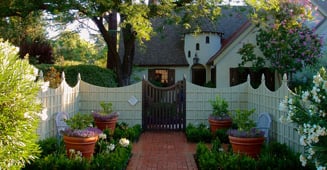

Contributor
- Topics: Archive

Last April 2,000 garden enthusiasts visited our Fresno property as part of the 2014 Master Gardener Spring Tour. We often welcome friends for brunch or dinner in the garden and even have an occasional garden party, but this level of sharing was out of the ordinary! By working steadily on a complete front yard makeover begun in February of 2013, we avoided any last minute panic in the weeks leading up to the tour and were ready to welcome visitors to our new garden.
Fresno is blessed with a lovely mediterranean climate that encourages outdoor living for most of the year. Spring and fall are simply spectacular. Winters are cool; rainy spells and occasional fog keep us inside but sunny days are plentiful during these months as well. Brutal summer heat, with daytime temperatures soaring above 100°F, drives us indoors, but once the sun sets we enjoy delightful, comfortable evenings in the garden.

Given Fresno’s climate, we turned to the cultures of the Mediterranean Basin for design inspiration. That sun-drenched region, from which the mediterranean climate pattern takes its name, has rich gardening traditions derived from centuries of experience. The Romans, taking design cues from the Greeks and the ancient cultures of the Middle East, were avid gardeners. They combined form and function, beauty and practicality in their garden designs. In fact, mention of the art of topiary can be found in descriptions of Roman gardens in existence more than 2,000 years ago. Beautiful sheared hedges did double duty as windbreaks or privacy screens. Fruit trees, such as lemons and olives, were planted as lovely specimen trees while also providing essential culinary elements. In Tuscany and Provence, which was once part of the Roman Empire, present-day gardens charm with this lovely mix of the useful and the sublime. Designed to extend daily life into the garden, homes in these regions incorporate a variety of outdoor spaces to take advantage of different sun exposures. This makes it possible to eat outside any time of the day and during any season of the year.
In choosing plants for our project, we felt it was important to use species suited to our mediterranean climate. This was not a sacrifice: the mediterranean plant palette is full of lovely trees, shrubs, bulbs, and ground covers that provide year-round interest and require little water. Many of these plants were readily available and already in use in local landscapes. In fact, for Fresnans fortunate enough to visit Mediterranean gardens abroad, it can feel like “old home week.” Lemon, olive, and fig trees abound. Oleander, boxwood, rosemary, and lavender are ubiquitous, as are sages and succulents. The savvy California gardener would easily recognize most of what is growing on the Riviera.

Frequent summer watering works against the natural rhythm of plants adapted to a mediterranean climate and many of these species look robust with only minimal irrigation. (For an excellent guide see The Dry Gardening Handbook by Olivier Filippi.) Liberally watering when daytime temperatures hover around 100°F. may make plants look lush but it can shorten their life span by pushing unnatural growth that is more prone to pests and disease. We were willing to accept that many drought tolerant plants would slow their growth under the withering heat of a Fresno summer and reserve their energy for the fall growth cycle when rain returns. Plants that require more pampering are relegated to a shady corner where we can easily supply extra water to their roots.

We worked with talented landscape designer Robert Truxell who created an ingenious plan for the entire front of our property. The existing semi-circular driveway, while convenient, made the yard seem a bit like a roadway. There was no welcoming walk to the front door and the drive cut the front lawn into several oddly shaped “silly lawns,” as garden author John Greenlee might call them. The driveway’s resemblance to a country road even encouraged the occasional passing car to drive through the yard and allowed unwanted solicitors to wander to the front door.

Robert’s plan addressed all of these issues while also satisfying our romantic fantasy of having a pétanque court. This area of hard-packed, decomposed granite allows us to play a friendly game of pétanque with guests or dine at a long table under an allée of ‘Natchez’ crape myrtles.
Work in Progress
A picture is worth a thousand words—browse the photos below documenting our project’s development. We couldn’t be more pleased with the outcome and the visitors we welcomed on the Master Gardeners’ Spring Tour were appreciative and inspired by what they saw. A win-win for all!







Read more about the author’s garden renovation on her blog La Dolce Vita California.
University of California Master Gardener volunteers provide the public with research-based information about home horticulture, pest problems, landscape management, and environmental and other natural resource issues. Interested adult volunteers go through a 16-week training and certification course. Training topics include botany, plant diseases, insects, weed science, home vegetable gardening, fruit trees and grapes, landscape trees, turf, and diagnosing plant problems. In exchange for training and materials received, Master Gardeners perform a variety of volunteer services and keep up to date on the latest science at monthly in-service meetings. The Master Gardener Spring Tour is the organization’s primary fundraiser for the year.
Share:
Social Media
Garden Futurist Podcast
Most Popular
Videos
Topics
Related Posts

Ground Up Science for Greener Cities with Garden Futurist Dr. Alessandro Ossola
Spring 2023 Listen to the Podcast here. Alessandro Ossola is a scientist who gets very excited about the challenge of climate change allowing for an

Readying Urban Forests for Climate Realities with Garden Futurist Dr. Greg McPherson
Winter 2023 Listen to the Podcast here. “Going from the mow and blow to a more horticulturally knowledgeable approach to maintaining the landscape. And that

January Showers Bring February flowers…
Fall 2022 It may not quite have the same ring to it as the old English proverb, but it has a lot more truth to

Low Maintenance Gardens – Better for Pollinators and People
Autumn 2022 “I come out every day. It’s therapy, my meditation.” Janet’s young garden transformed from overgrown, invasive plants to mostly natives. The dailiness of









Responses